The benefits of content marketing can be enormous. However, all too often, new entrants make the mistake of considering content marketing some form of free advertising.
Then they discover the error of their ways. (1) It’s not advertising and (2) it’s not free.
Content marketing: it's not advertising and it's not free. But the best practitioners enjoy 15 big benefits. Share on XLet’s put these myths to bed. You see, publishing a blog, creating a video series or podcast, populating your website with digital this-and-that, or taking to social media with regular updates—none of it’s free.
It takes resources to produce and publish content—namely people—and then again some to promote it.
If you were led to believe otherwise, you were misled. And if you’re of the opinion organic search and social deliver the digital magnets you need to pull a steady stream of prospects to your website, chances are you got in early and mastered those channels before the competitive landscape went crazy.
Most companies did not get in early and so content marketing is a war zone upon which surviving and thriving is heavily dependent on shrewd execution.
The myth-busting portion of this post ends here. Let’s dive into the powerful benefits of content marketing now.
1. Search engine visibility
In my mind, appearing on the first page of search engine results pages ranks atop the list of content marketing benefits.
- You don’t pay to rank. (And please, don’t hire those BS artists that invade your inbox promising miraculously fast results.)
- Ranking high has staying power far beyond the realm of creating a buzz on social media or buying any form of advertising.
- Intent to buy is often high.
71% of consumers begin their journeys by using a search engine to discover new products and services. 74% use a search engine for consideration and purchasing (research, comparison, transaction). Source: Why Search + Social = Success for Brands, Forrester Consulting
I don’t want to get boring or technical here, but I do want to put forth the essential idea that search results are largely based on the authority of your website.
You don’t get the authority vital to the visibility of your website by publishing a few sales pages or a portfolio. You get it by publishing helpful, entertaining and inspiring content that people enjoy.
And you get it very gradually, which is to say, you build authority slowly, over time, if and only if, the search engines detect signals that people are consuming into your content.
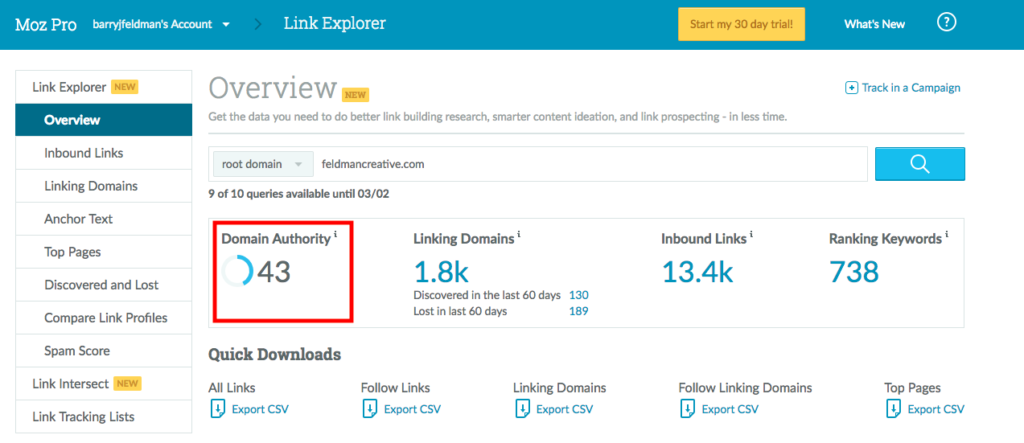
The domain authority of Feldman Creative is currently 43. Not bad, I suppose, but in a perfect world, it’d be 57 points higher.
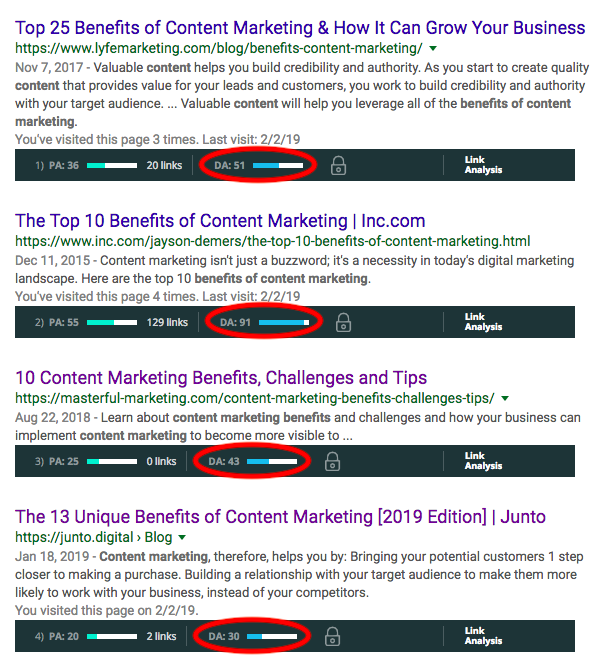
I’d love to see this post rank for the phrase, “benefits of content marketing” (and maybe more). It looks like I’ll contend with posts and pages ranking for the same phrase with DA as low as 30 and as high as 91.
I’m now talking about a different type of authority, that is your reputation as a credible source of expertise. Many like to refer to it as “thought leadership.”
Domain authority (a term coined by Moz) is quantitative. Owning a leadership position is qualitative and subjective. And, of course, it’s precious. When you’re recognized to be the go-to source for insights within a specific niche, those that consume your content become far more likely to consume your products as well.
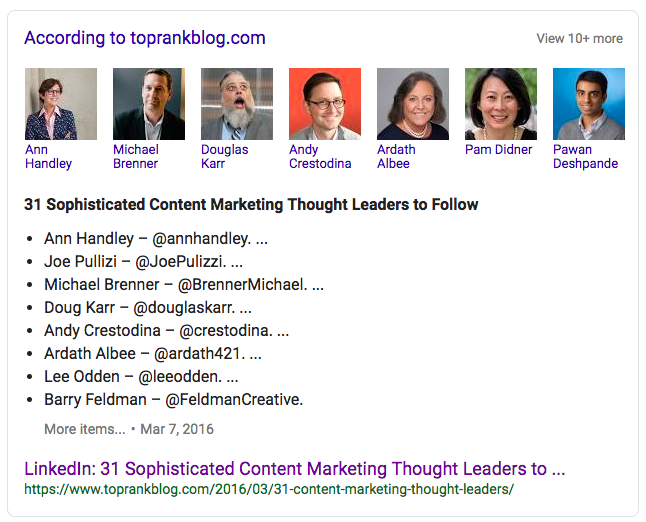
“Content marketing thought leaders…” I don’t love the description, but like the idea I made TopRank’s list. 😉
4. Website stickiness
The benefits of content marketing expand when your website gets stickier. That is, visitors stick around and click around.
- It doesn’t happen when your content’s crap.
- It doesn’t happen if your content is overly heavy with self-promotion.
- It’s unlikely to happen if you only offer one or two strong pieces of content.
Like with a book, or a movie, or an album, or any form of content, people stick with it when they’re interested. They tune-out when they’re not.
5. Referral traffic
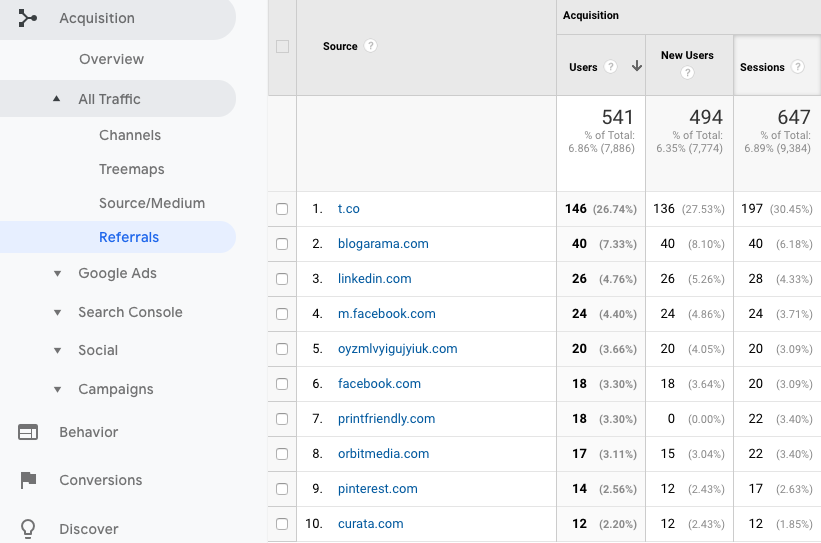
Referral traffic looks like this in Google Analytics. You can dig into your Google Analytics at any time and see the sources driving referral traffic to your site and gather all kinds of data regarding them.
Referral traffic is the traffic you earn from sources other than a search engine. Where’s it come from? The wild web. Does that mean you have no control over it? Yes and no.
Good content marketers create content others read, view, find, borrow from, quote, promote, and link to.
Great content marketers are proactive about making it happen. They create content explicitly for high profile publishers and collaborate with influencers. The key here is guest blogging, various forms of PR, and social media activity.
I built my audience by publishing content on sites far more popular than my own. The result was—and still is—referral traffic.
6. Referrals
A content marketing benefit that’s not heralded to the degree it should is good old-fashioned word-of-mouth referrals. Of course, email, social, chat and other channels can be word-of-mouth accelerators. Regardless of the media, consider how content can fuel business referrals…
- “You should work with my advisor. Look at this amazing guide he sent me.”
- “You have to check out this crazy cool gallery of X I saw on Y.”
- “I recommend this software solution because they have a video that answers any question you have.”
- “Hey, I want you to check out this amazing template that makes it so easy to do X, Y and Z.”
- “If you don’t know which size or model you need, you have to go to this page. It offers an assessment that ensures you make an informed decision.”
Yes indeed. Content marketing sprinkles pixie dust on word-of-mouth marketing.
7. Social media followers
As this list expands, it’s impossible not to recognize how obvious it is the benefits and tactics that make them happen are interrelated.
Social media and content are not the same thing, but they’re certainly bedfellows. The benefits of content marketing come pouring forth in social media—and vice-versa.
Prospects that find valuable content on your site will often become advocates for your brand on social. Those that discover you on social could very well head for your website, blog and email list. They’re likely to follow your links and track you down on other social channels.
You get more followers. More shares. More readers. More buzz. More of each of the benefits we’ve discussed so far as well as what follows.
8. Lead generation
Unsurprisingly, lead generation is the content marketing benefit most companies covet and therefore want to talk about first. When it comes time to forge a budget for the people, processes and practices you’ll need, you’ll obviously need to demonstrate content marketing is generating leads (or has the potential to).
But you’ll notice I didn’t dive into this benefit first. Lead generation happens when you get your act together up and down your content marketing operation and offer valuable content across the various stages of the buyer’s journey.
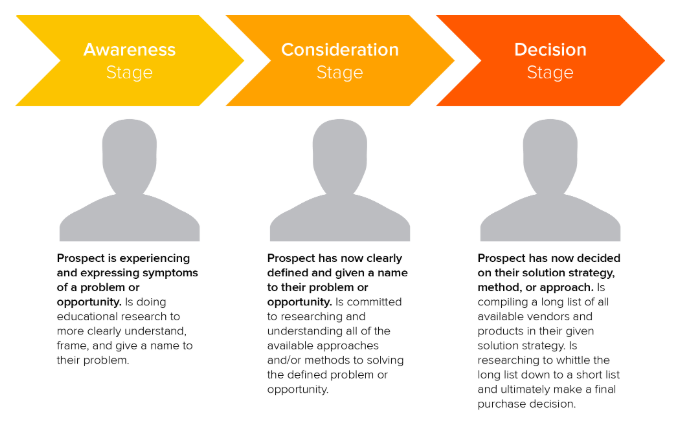 The buyer’s journey, as depicted here in a graphic by HubSpot, generally comprises three stages: awareness, consideration and decision.
The buyer’s journey, as depicted here in a graphic by HubSpot, generally comprises three stages: awareness, consideration and decision.
9. Conversion
“Content marketers create and promote useful, relevant information with the goal of attracting and engaging website visitors and then converting those visitors into leads and customers.”
~ Excerpt from Content Chemistry by Andy Crestodina.
Amen to that, Andy.
Show me someone who’s great at educating, entertaining and inspiring and I’ll show you a potential A+ content marketer. And an A+ content marketer sells—or at least has a significant role in the sales process.
While first and foremost content marketing should deliver value to your audience, it also helps create demand. It “converts.” Content can and should inspire opt-ins, trials, downloads, requests for more information, consultations, proposals, and of course, sales.
The sales funnel often involves multiple steps and activities, some of which are painstakingly slow. One of the best ways to speed up sales funnel activities and convert more leads is through highly targeted content.
10. Marketing and sales alignment
Companies that align sales and marketing generate higher quality leads, win more customers, and realize higher customer retention rates. However, only about 8% of companies have strong alignment between sales and marketing, according to Forrester.
Gulp.
Marketing and sales teams tend to neglect the power of working together. Often, the two departments don’t have a clue what’s going on beyond their silo. They don’t communicate, work toward the same metrics, or team up to improve important processes.
The content marketing process has huge potential to solve this expensive problem. Content marketing becomes the bridge that brings the sales and marketing team together. Imagine what kind of magic could happen when sales and marketing collaborate to:
- Define the ideal lead
- Develop customer personas and segments
- Identify friction points in the sales funnel
- Collaborate on content creation
- Strategically promote and distribute content
- Measure progress and refine programs and processes
11. Sales enablement
Sales enablement is one of the results of marketing and sales getting on the same page. Marketers support salespeople with the content, training, and analytics they need to build relationships and win business.
Aberdeen Group research found companies with an effective sales enablement content strategy in place excelled at creating a reliable pipeline with higher revenues. Best-in-class sales-enabled companies outperformed the competition, on average generating twice as much total company revenue and twice the average deal size. Sales-enabled sellers massively outperformed their competitors in lead conversion as well.
I wrote an in-depth article on the topic for MarketingProfs, in which I explained a three-step path to creating an effective collaborative project:
- Map the buyer’s journey. Identify what questions need to be answered at each stage.
- Create a content awareness initiative. You need to develop a process that ensures salespeople are up to speed on the “inventory.”
- Enable content personalization. Put processes in place enabling sales professionals to make the content as specific as possible to increase its value to the prospect.
12. Grow email lists
Email is an essential component of digital marketing programs in so many important ways. Naturally, the following loom large on the content marketer’s priority list:
- Grow the size of your email list(s). Think reach.
- Improve the quality of your email list(s). Think relevance.
- Nurture leads with email marketing. Think engagement.
There are a variety of ways content marketers can accomplish the above, but the one I feel compelled to stress here is to offer lead magnets. Not every company does, but every company should.
A lead magnet is a free offer you make in exchange for an email address. They can take so many forms (cheat sheet, ebook, webinar, assessment, free course, coupon, etc.).
I offer them all over my site. I’ll insert a few here to demonstrate what an opt-in box looks like and (hint-hint) invite you to take advantage of the content and join my email list.
13. Improve customer service
“Content marketing makes life way easier for your customer service team.” (I got that from a post on the benefits of content marketing by Junto and I’m going to borrow even more from it now…)
Does your customer service team answer the same questions every day?
Whether it’s how to reset your password or how to use your product, take the time to write an informative answer to those questions. Compile those into a blog post or series of blog posts that your customer service team can share when they get those regular questions.
Many customers will even find these answers through an online search instead of reaching out to your customer service team, to begin with.
14. Build customer relationships
More touchpoints, more touches; more touches, more meaningful relationships. Simple, right?
The content you publish on your site and share on other channels increases the number of opportunities you have to engage your audience, and potentially, start a conversation.
Also, delivering a steady stream of great, useful content helps your brand build bonds with existing customers—and employees, partners, industry pundits, etc.
Customers that rely on you as a primary source of information that helps them do their jobs better or live more gratifying lives are bound to stick around, buy more often, advocate for your brand and refer friends.
15. Lower marketing costs
Content marketing is more cost-effective than traditional marketing tactics…
And yaddada yaddada… I could go crazy with an array of numbers the respected experts such as HubSpot, Content Marketing Institute and MarketingProfs have researched and espoused. I don’t need to. You get it.
Content marketing can slash your marketing costs. When you get it working, you can indeed dial-down your ad spend. And your ROI compounds over time.
So… will you lower your marketing costs with content marketing? You might.
But understanding the benefits of content marketing’s not enough to get you there. And given the immense competition, you definitely won’t get there by simply playing along.
You’ll realize the benefits of content marketing we covered in detail here today when you commit to becoming the best in your business for the long haul.

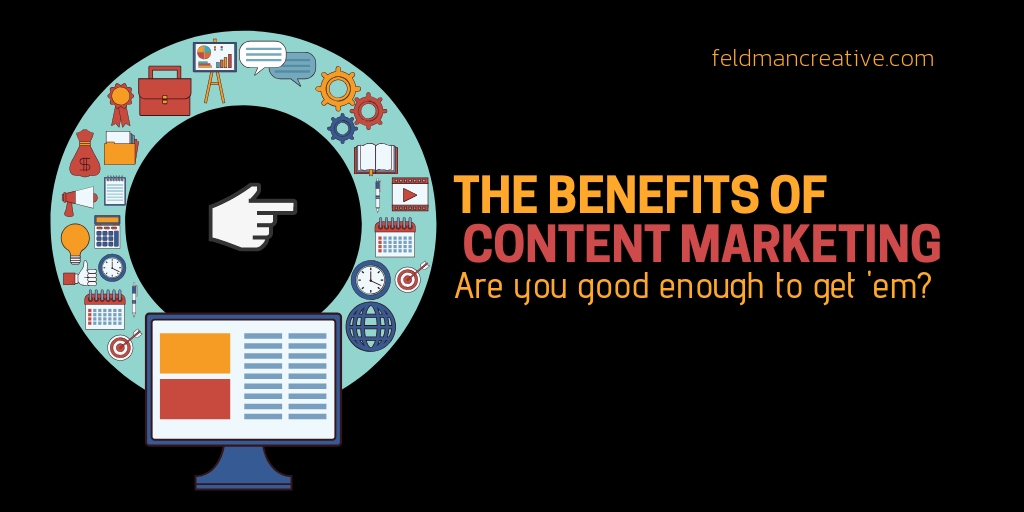


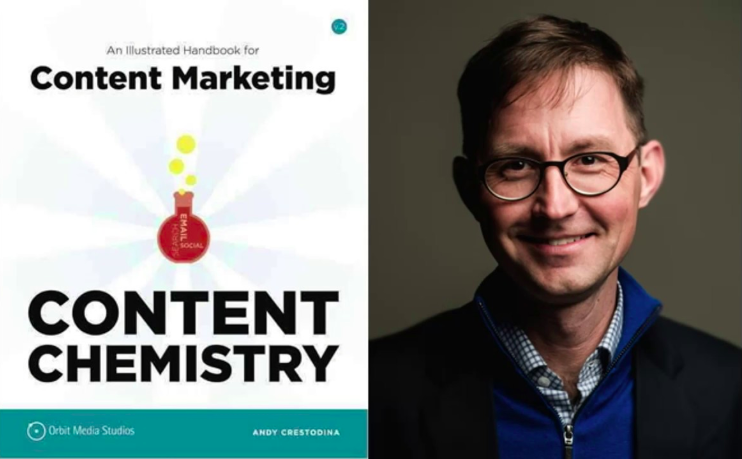
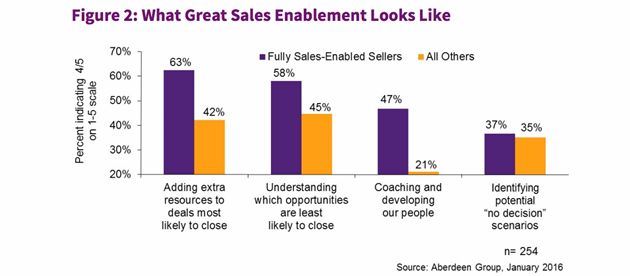

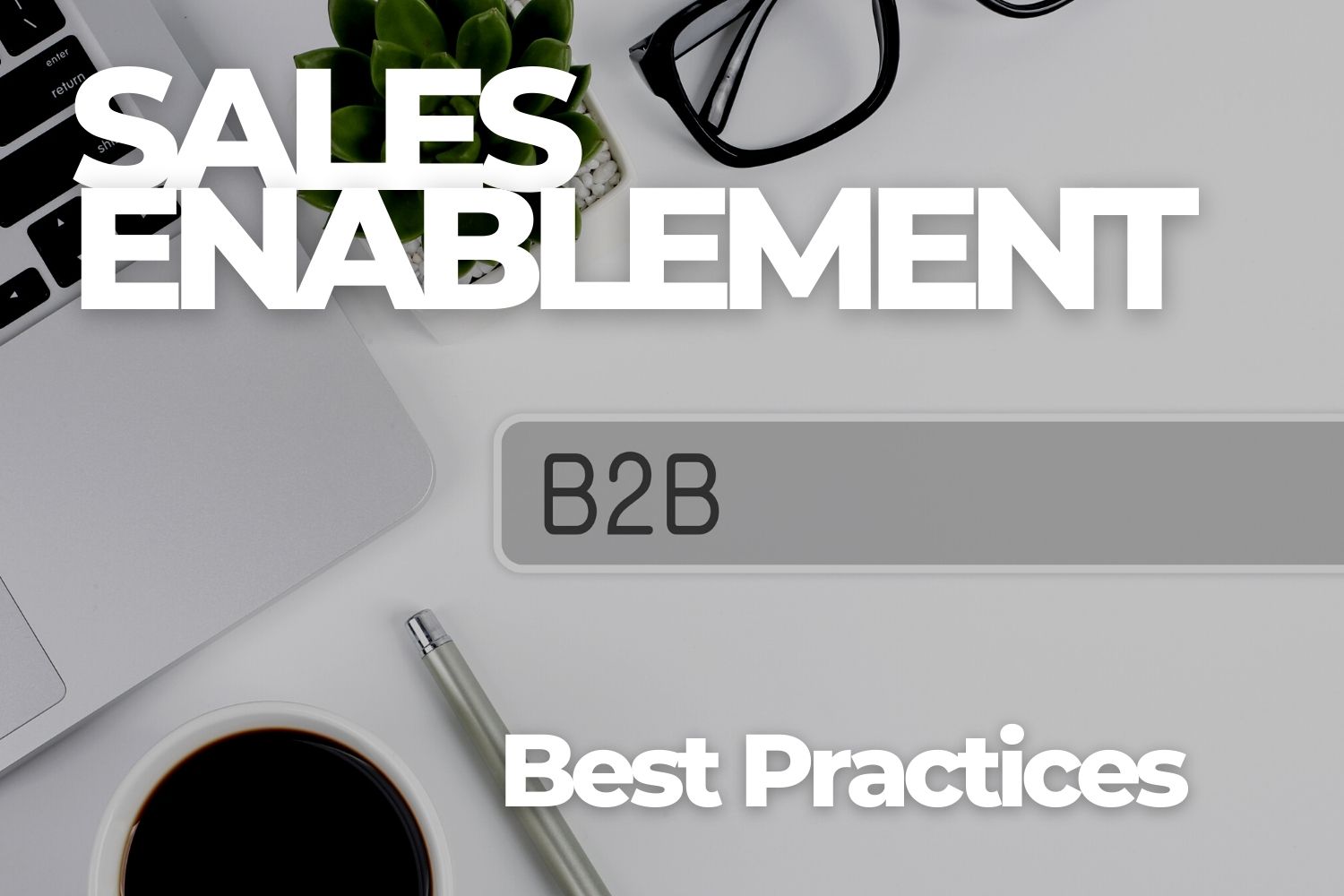

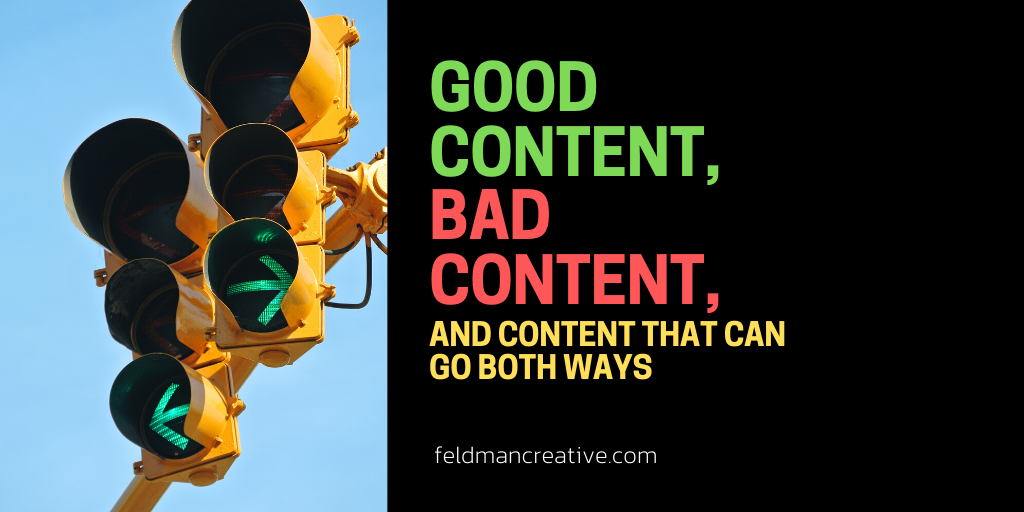
Comments
Alison
Thanks for the great info! I think #14 is especially important and too often overlooked when it comes to content marketing. Too many people want to get straight to the sale and they forget about the importance of building relationships before the sale can happen.
VEPAMBATTU CHANDU
Great Article Good Explanation Thanks For Sharing
The 15 Big Benefits of Content Marketing (Reserved for the Best)
[…] Sourced through Scoop.it from: feldmancreative.com […]